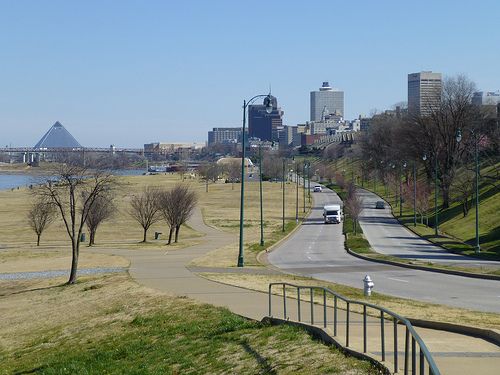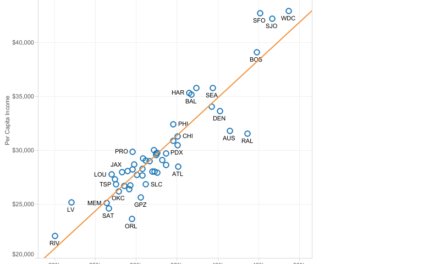Thumbnail: After seven years of blog posts about the need for Riverside Drive to contribute to a livable Memphis, the street is opening up again today for five days a week so it seems a good time to revisit past blog posts about how it could contribute to a livable Memphis.
**
Riverside Drive opened up again today after being closed since March 31, and there’s even more evidence that there’s little reason to do it. (UPDATE: Since Memphis did not move to Covid-19 Level 3 today because of an uptick in cases, the opening of Riverside Drive has been delayed.)
Memphis Mayor Jim Strickland closed the street as a precaution against Covid-19 and favors a four-lane version of it, and Memphis River Parks Partnership’s position is for four lanes as reflected in the mediation agreement with Memphis in May. Mayor Strickland’s order will keep the street closed on Saturday and Sunday.
However, there’s compelling evidence that Riverside Drive should be two lanes and perhaps even remain closed.
There’s traffic engineering data that prove the street has too much capacity for the amount of traffic it carries on four lanes. Now, after its closing for 10 weeks, we also have the proof of new and better uses by visitors to the riverfront without the intrusive noise from the highway and with the additional 30% in area for strolling, biking, and skating.
Most importantly, a closed Riverside Drive provides safer access to Tom Lee Park.
It’s a mystery why any suggestion that Riverside Drive should remain closed or reduced to two lanes engenders outrage and enmity by some, including so many people who don’t even travel on it and others who use it as a proxy for something else they’re upset about.
The Data
The engineering data are conclusive:
* The traffic count on Riverside Drive (pre-covid-19) is 29% lower than it was in 2001.
* The capacity for Riverside Drive is on average about 20,000 vehicles a day, but the average traffic count is only about 13,000.
* Overall, downtown streets are under capacity when compared to 20 years ago.
* The City Engineering Department reported that drivers on the two lanes during the pilot project a few years ago exceeded the posted speed limit and traffic counts on downtown streets remained the same.
The emotions surrounding Riverside Drive alternatives are reminiscent of the great biking controversy of a few years ago. As soon as city government announced its plans for bike lanes to become part of city street projects, there were howls of protests. And yet, today, Memphis boasts of moving from a city labeled “one of the worst cities for cycling” with two miles of bike lanes to one today with 300 miles of them and praised nationally.
Much More Than A Road
In other words, a livable city doesn’t come easy. And some people can’t see the benefit until it is done.
That’s why the debate about Riverside Drive is about much more than a road. In truth, it is another indication of how tenuous the movement for a more livable Memphis is.
As nationally known planner, New Urbanist, and author Jeff Speck said here in 2013: “Riverside Drive is the highway that was famously killed to become a parkway, but now functions too much like a highway, speeding cars in a seam between the city and its riverfront. The answer to this question (about Riverside Drive) can be found each May, when one-half of the street is closed for two weeks and the entire street is closed for three weeks.
“While presenting some temporary inconvenience as people adjust their paths, the City’s grid of alternative north-south streets contains more than adequate capacity to absorb the trips typically handled by Riverside Drive. Such an experience has been mirrored in American cities from coast to coast, where highway removals have repeatedly failed to cause traffic crises. From New York’s West Side Highway to San Francisco’s Embarcadero Freeway, removed road capacity has not had a negative impact on travel times.
“For this reason, and as further studied by transportation engineers at Nelson/Nygaard Consulting Associates, we have the luxury of asking ourselves what kind of street Riverside Drive wants to be. Surely it can still hold cars, but the downtown would benefit tremendously if it were to hold cars moving a bit less speedily, alongside pedestrians and cyclists.”
He said Riverside Drive “should be converted from a four-lane speedway to a two-lane ‘complete street,’ including parallel parking and a bicycle track along the Mississippi River. Additionally, the inclusion of parallel parking would both provide protection to its sidewalks while eliminating the need for parking lots within Tom Lee Park and at Beale Street Landing.”
Focusing On Quality Life, Not Cars
It’s surprising how worked up some people can get at just the mention of a two-lane Riverside Drive, much less closing it. They act as if its closing for 10 weeks has actually resulted in problems. They even inaccurately claim the number of visitors to the park is down.
The angst that erupts anytime the conversation turns to creating a smarter Riverside Drive, defies the kinds of actions taken in other cities like San Francisco, Portland, Boston, Milwaukee, Chattanooga, Akron, Philadelphia, and Niagara Falls, which are removing highways on their riverfront altogether.
Paris even shuts down the busiest lanes of traffic on the banks of the Seine. There, two lanes of roadway are turned into a 1.4 mile pedestrian boulevard packed with recreational activities, restaurants and bars, and creative patches of blooming flowers of plants and trees. There are even teepees that can be reserved for children’s birthday parties, a painted maze, and a sprinting track. Previously, the two lanes moved as many as 2,200 cars an hour, but today, they attract 2.5 million people to it.
Surely, if a world capital like Paris can reimagine its streets, Memphis can at least consider that Riverside Drive can be a much greater positive impact than it is today. We should have learned long ago the lessons about how a singular focus on cars has degraded the quality of life of Memphis and Shelby County, driving up public debt, increasing maintenance costs, and paving over potential for a more livable city.
There’s little doubt that traditional thinking here has produced too many roads with too many lanes in too many places. Lessons in Memphis teach that changes may be difficult, but once in place, they receive wide support of the city’s character.
Riverside Drive can be much more than it is in creating more of the park-like setting that the riverfront deserves rather than a highway that degrades park-goers’ experiences.
**
Click here to join us at the Smart City Memphis Facebook page for daily articles, reports, and commentaries that are relevant to Memphis.





This is article completely moronic, obviously written by someone who is either semi retired or oblivious to the reality that the need for our vehicles will be here for a long time. Lack of good transit and Covid will extend the time. Livability is not having traffic clogging Downtown Streets and where they have turned into all night raceways. We need to open a 4-lane Riverside now.
There is no logical reason for four lanes. Period. Instead of your weak insults, how about debating the facts? Engineering data, traffic patterns, and downtown street capacities are conclusive.
Too many people who kneejerk oppose changes to Riverside Drive seem to just want to oppose it because certain other people support it and as a result, they close their mind to the facts. What fact can you provide to support your opinion.
https://www.commercialappeal.com/story/opinion/2019/06/11/turning-riverside-drive-into-two-lanes-vital-riverfronts-success/1414659001/
PS: Although I wish I was semi-retired, I’m baffled as to why that has anything to do with anything except your weak attempt at an insult.